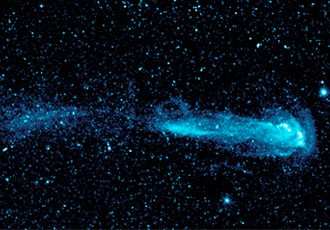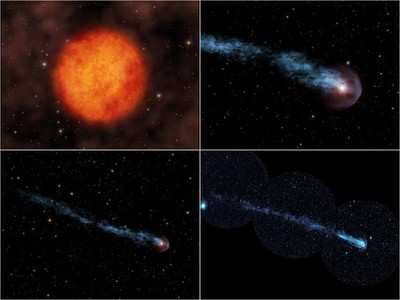NASA Says Comet-Like 'Tail' Contains Carbon, Oxygen
 When is a star also a
comet? NASA scientists should have a fascinating time answering
that question, posed recently after the agency's Galaxy Evolution
Explorer spotted an amazingly long comet-like tail behind a star
streaking through space at supersonic speeds.
When is a star also a
comet? NASA scientists should have a fascinating time answering
that question, posed recently after the agency's Galaxy Evolution
Explorer spotted an amazingly long comet-like tail behind a star
streaking through space at supersonic speeds.
The star, named Mira after the Latin word for "wonderful," has
been a favorite of astronomers for about 400 years. It is a
fast-moving, older star called a red giant that sheds massive
amounts of surface material.
The space-based Galaxy Evolution Explorer scanned the popular
star during its ongoing survey of the entire sky in ultraviolet
light. Astronomers then noticed what looked like a comet with a
gargantuan tail. In fact, material blowing off Mira is forming a
wake 13 light-years long, or about 20,000 times the average
distance of Pluto from the sun. Nothing like this has ever been
seen before around a star.
"I was shocked when I first saw this completely unexpected,
humongous tail trailing behind a well-known star," said Christopher
Martin of the California Institute of Technology in Pasadena, CA.
"It was amazing how Mira's tail echoed on vast, interstellar scales
the familiar phenomena of a jet's contrail or a speedboat's
turbulent wake."
Martin is the principal investigator for the Galaxy Evolution
Explorer, and lead author of a Nature paper that appeared this week
about the discovery.
Astronomers say Mira's tail offers a unique opportunity to study
how stars like our sun die and ultimately seed new solar systems.
As Mira hurtles along, its tail sheds carbon, oxygen and other
important elements needed for new stars, planets and possibly even
life to form. This tail material, visible now for the first time,
has been released over the past 30,000 years.
"This is an utterly new phenomenon to us, and we are still in
the process of understanding the physics involved," said co-author
Mark Seibert of the Observatories of the Carnegie Institution of
Washington in Pasadena. "We hope to be able to read Mira's tail
like a ticker tape to learn about the star's life."
Billions of years ago, Mira was similar to our sun. Over time,
it began to swell into what's called a variable red giant -- a
pulsating, puffed-up star that periodically grows bright enough to
see with the naked eye. Mira will eventually eject all of its
remaining gas into space, forming a colorful shell called a
planetary nebula. The nebula will fade with time, leaving only the
burnt-out core of the original star, which will then be called a
white dwarf.
Compared to other red giants, Mira is traveling unusually
fast... possibly due to gravitational boosts from other passing
stars over time. It now plows along at 130 kilometers per second,
or 291,000 miles per hour. Racing along with Mira is a small,
distant companion thought to be a white dwarf. The pair, also known
as Mira A (the red giant) and Mira B, orbit slowly around each
other as they travel together in the constellation Cetus 350
light-years from Earth.
In addition to Mira's tail, the Galaxy Evolution Explorer also
discovered a bow shock, a type of buildup of hot gas, in front of
the star, and two sinuous streams of material coming out of the
star's front and back. Astronomers think hot gas in the bow shock
is heating up the gas blowing off the star, causing it to fluoresce
with ultraviolet light. This glowing material then swirls around
behind the star, creating a turbulent, tail-like wake. The process
is similar to a speeding boat leaving a choppy wake, or a steam
train producing a trail of smoke.

The fact that Mira's tail only glows with ultraviolet light
might explain why other telescopes have missed it. The Galaxy
Evolution Explorer is very sensitive to ultraviolet light and also
has an extremely wide field of view, allowing it to scan the sky
for unusual ultraviolet activity.
"It's amazing to discover such a startlingly large and important
feature of an object that has been known and studied for over 400
years," said James D. Neill of Caltech. "This is exactly the kind
of surprise that comes from a survey mission like the Galaxy
Evolution Explorer."
 ANN's Daily Aero-Linx (04.16.24)
ANN's Daily Aero-Linx (04.16.24) Aero-News: Quote of the Day (04.16.24)
Aero-News: Quote of the Day (04.16.24) Airborne 04.10.24: SnF24!, A50 Heritage Reveal, HeliCycle!, Montaer MC-01
Airborne 04.10.24: SnF24!, A50 Heritage Reveal, HeliCycle!, Montaer MC-01 Airborne 04.12.24: SnF24!, G100UL Is Here, Holy Micro, Plane Tags
Airborne 04.12.24: SnF24!, G100UL Is Here, Holy Micro, Plane Tags Airborne-Flight Training 04.17.24: Feds Need Controllers, Spirit Delay, Redbird
Airborne-Flight Training 04.17.24: Feds Need Controllers, Spirit Delay, Redbird




